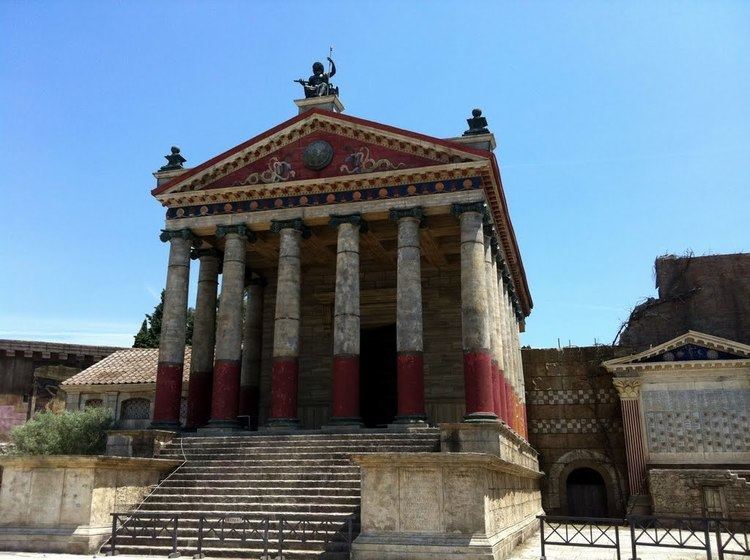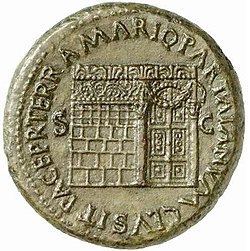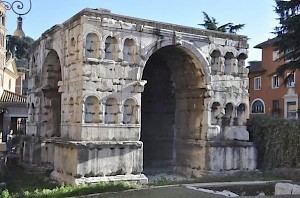 | ||
Architectural style Ancient Roman architecture Similar Shrine of Venus Cloacina, Temple of Concord, Vulcanal, Basilica Aemilia, Temple of Vespasian and Titus | ||
Temple of janus roman forum
In ancient Rome, the main Temple of Janus stood in the Roman Forum near the Argiletum. It had doors on both ends, and inside was a statue of Janus, the two-faced god of boundaries. The Temple doors (the "Gates of Janus") were closed in times of peace and opened in times of war.
Contents

According to Livy 1.19 the second king of Rome, Numa Pompilius, decided to distract the early, warlike Romans from their violent ways by instilling in them awe and reverence. His projects included promoting religion, certain priesthoods, and the building of temples as a distraction with the beneficial effect of imbuing spirituality. The Temple of Janus was Numa's most famous temple project.
Ancient descriptions
Plutarch, in Life of King Numa, wrote:

[Janus] also has a temple at Rome with double doors, which they call the gates of war; for the temple always stands open in time of war, but is closed when peace has come. The latter was a difficult matter, and it rarely happened, since the realm was always engaged in some war, as its increasing size brought it into collision with the barbarous nations which encompassed it round about. But in the time of Augustus it was closed, after he had overthrown Mark Antony; and before that, when Marcus Atilius and Titus Manlius were consuls, it was closed a short time; then war broke out again at once, and it was opened.
Gates of Janus

During Numa's reign, the Gates of the Temple of Janus were closed and Rome remained at peace. The next king, Tullus Hostilius, opened the Gates of Janus when he went to war with Alba Longa. The Gates of Janus remained open for the next 400 years until after the First Punic War when T. Manlius Torquatus closed the Gates of Janus in 235 BC. This closure lasted about eight years. War with the Gauls in Northern Italy forced the Gates of Janus to reopen. They did not close again until 29 BC, following the deaths of Antony and Cleopatra.
The Res Gestae Divi Augusti, a first-person account of the life of Augustus, claims:

Janus Quirinus, which our ancestors wished to be closed whenever peace had been secured by victories throughout the Roman empire by land and sea, was recorded to have been closed, before I was born, twice altogether since the foundation of the city, but the senate decreed that it should be closed on three occasions while I was princeps.

From Cassius Dio 51.20 and 53.27 we are able to date the first two closures to 29 and 25 BC respectively.
The exact date of the third closure remains a scholarly debate. The only ancient author to date the third closure was Orosius, who associates the event with the birth of Christ, c. 1 BC. However, modern scholars almost universally reject Orosius because Roman armies were campaigning in Germany and/or the Far East elsewhere by 2 BC. Inez Scott Ryberg and Gaius Stern date the third closure to 13 BC based on the joint return of Augustus and Agrippa to Rome after pacifying the provinces. Sir Ronald Syme dated the closure to 7 BC, to coincide with the triumph of Tiberius and his second consulship, the events of which year are lost in a gap in the surviving manuscripts of Cassius Dio. Mario Torelli followed Orosius' date.
Later emperors also closed the Gates of Janus to great fanfare. The most famous closures occurred under Nero and Vespasian. Nero minted a large series of coins with the Ara Pacis (and the Temple itself with closed gates) on the reverse to commemorate this event. Other emperors certainly closed and reopened the Gates of Janus, but references in later and less thorough historians are fairly rare.
The Roman poet Virgil also includes in the Aeneid the opening of the Gates of Janus to start war between the Trojans and the Latins.
